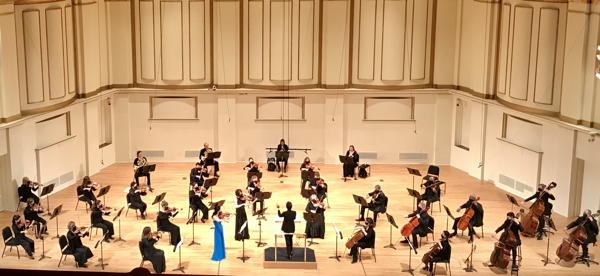
Review: Superlative Mozart and Respighi from Stephanie Childress and the SLSO
By
One of the delights of the recent live and digital concert series at the St. Louis Symphony Orchestra has been the way they have focused on the SLSO string section. I have been impressed with their sound for some time now, but I was most strongly reminded of it this past weekend (April 16-19) in the second two programs (the first was April 9-11) led by our new Assistant Conductor Stephanie Childress.
[Find out more about the music with my symphony preview.]
 |
| L-R: Xiaoxiao Qiang, Shannon Farrell Williams, Stephanie Childress |
This was most apparent in the work that closed the concert (which I saw on Saturday the 17th), the third and last of the "Ancient Airs and Dances" suites by 20th century Italian composer and musicologist Ottorino Respighi. That historical sensibility of the musicologist informs the “Ancient Airs and Dances” suites, which are transcriptions of the works of Italian composers from the 16th, 17th, and 18th centuries.
Written under the shadow of fascism in 1931, the third suite is the most dramatic and even melancholy of the three, and the only one written for string ensemble alone. With moods ranging from romantic yearning to tragic nobility, it calls for players with a wide expressive range and a conductor who is sensitive to both the work’s technical demands and its emotional depth.
Ms. Childress and the SLSO strings were all of that in abundance Saturday night. The opening “Italiana” flowed gracefully like the two galliards on which it’s based. The “Arie di corte” reflected the many mood changes of the six love songs that form its basis, from refined courtly romance to rustic lust, complete with a seriocomic imitation of a bagpipe drone. The “Siciliana” third movement seemed to radiate nostalgia and regret. It and the concluding “Passacaglia” demonstrated the robust, full-bodied sound of the full ensemble at its best.
The “Passacaglia,” in fact, was a remarkable achievement all by itself. It’s the only one of the four movements based, not on a lute tune, but rather on a work written for the more expressive Baroque guitar (by Count Ludovico Roncalli, from his 1692 “Capricci Armonici”). It covers a wider emotional range than many of the other originals, which may be one reason why Respighi chose to simply orchestrate it without substantial changes. The result is a work of tragic grandeur, and Ms. Childress and her forces gave us every ounce of that in this powerful and moving performance.
 |
| Ancient Airs and Dances |
The concert opened with a pair of works that allowed us to hear the SLSO winds in fine form along with their fellow members of the band, beginning with a bright and brash romp through the Overture in D major, written in 1790 by Italian-born virtuoso cellist and composer Luigi Boccherini. Xiomara Mass and Cally Banham were an elegant and precise presence on oboes, Roger Kaza and Julie Thayer bright and powerful on the horns, and the reliable Andrew Cuneo an elegant voice on bassoon. It was an excellent way to open the evening, and I was disappointed that the applause for it didn’t go on longer.
The Mozart Sinfonia concertante in E-flat major for Violin, Viola, and Orchestra, K. 364 was next, featuring excellent solo performances by violinist Xiaoxiao Qiang and violist Shannon Farrell Williams. Essentially a symphony with a group (a pair, in this case) of instrumental soloists, the sinfonia concertante was a popular form when Mozart wrote his for a 1779 European tour. His contribution to the form often gets high marks for the way it gives equal prominence to both of its solo instruments. Ms. Qiang and Ms. Williams made the most of that as they merrily flipped melodic lines back and forth and took their star turns at cadenzas both flashy (in the noble Allegro maestoso first movement) and heartfelt (in the romantic Andante second movement). I had the sense that I was watching a convivial musical conversation between them and Ms. Childress
Regarding that slow movement, Ms. Childress and the musicians gave it an especially poignant sense of what Shakespeare’s Duke Orsino calls “a dying fall” that “came o'er my ear like the sweet sound / That breathes upon a bank of violets.” It was a fine contrast to the brisk sense of occasion of the first movement and the elegant dance of the last.
Next at Powell Hall: Local favorite Leonard Slatkin returns Friday and Saturday at 7:30 pm and Sunday at 3 pm, April 24-26, to conduct Britten’s “Variations on a Theme of Frank Bridge,” Ravel’s “Tzigane” (with Assistant Concertmaster Erin Schreiber in the virtuosic solo part), and Ginastera’s demanding “Variaciones concertantes,” op. 23. Only 300 tickets will be sold for each performance and strict health protocols will be in place. For more information, visit the SLSO web site.
Meanwhile, the SLSO’s digital concert series continues with on-demand performances of “Night Music,” through April 24; “The Heart of the Matter,” through May 8; and, from April 22 through May 22, a concert from last fall’s chamber music series featuring works by Debussy, Ravel, and the mightily underrated Germaine Tailleferre.


